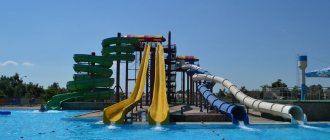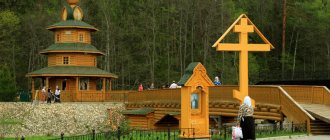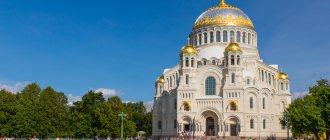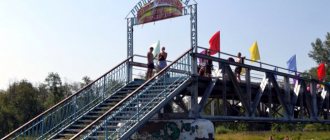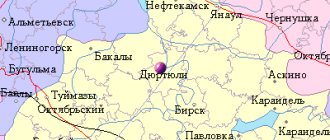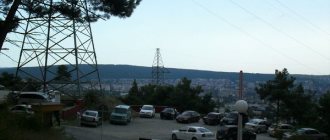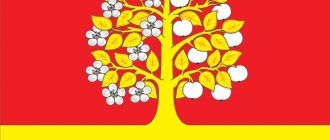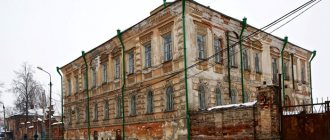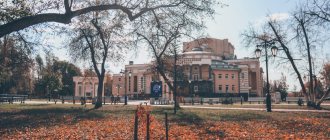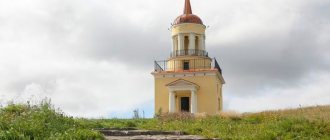The port city of Kronstadt is the most remote suburb of St. Petersburg, which was founded by Peter the Great as a defensive settlement. Its location was ideal for the development of maritime affairs. The first icebreaker in the world was built here, the Baltic Fleet appeared and hydraulic engineering innovations of that time were installed. The place played a significant role in the development of the country, so tourists should come here for new experiences.
Short description
Kronstadt is a Russian port city located on the island of Kotlin in the Gulf of Finland. Today, about 44,000 people live on its territory of 19.35 km². Translated from German, the word “Kronstadt” means “City – Crown” , “Fortress – Crown”. The name reflects the significance of the place. Initially, the city served as a shield for St. Petersburg from enemies from the sea.
are organized daily from St. Petersburg to Kronstadt , then you can familiarize yourself with various excursion programs.
View this post on Instagram
I walked around Kronstadt. When God saw #Kronstadt he came up with autumn. But in general - see for yourself. The only thing is that the video shows a bunker, not a bunker. A bunker is a simpler construction.
A post shared by Interesting things in St. Petersburg (@walkingontheroofs) on Sep 23, 2021 at 6:50am PDT
Andreevsky Square
Kronstadt has all the features of a truly Russian city: an abundance of stone, an amazing combination of tall, geometrically correct forms, a serene expanse of water, and a thick canopy of greenery that hides the most hidden sights from prying eyes.
St. Andrew's Square is one of the most ancient gardens in the city, which was once densely planted with rare shrubs and graceful trees. All this has now turned into a riot of colors in the tall crowns of trees, among the branches of which birds have found refuge. Under their wonderful singing, local residents and guests of the city immersed themselves in their thoughts, regained the strength spent during the day and prayed for the health of their relatives and friends.
This place is located very conveniently in relation to other attractions, therefore it is included in almost all excursion programs. You will definitely be invited to take memorable photos near the temple-chapel, erected in honor of the Tikhvin Icon of the Mother of God and located next to the shrine of a large stone monument, a sign on which calls for mourning for the shrines desecrated by the authorities.
Story
Base
Kotlin Island occupies a strategically important position. With its help it is convenient to control the movement of ships in the Gulf of Finland. The location made it a coveted target and a point of contention between Sweden and Russia . In the 14th century it was a border zone between states, but in 1617 it came into the possession of the Swedes.
To strengthen his position, Peter the Great needed an island. The winter of 1703-1704 became a turning point. After the Swedish ships sailed, Peter ordered to secretly occupy Kotlin and begin building fortifications. In the spring, the arriving Swedes were met by Russian troops. In 1704, the Kronstadt fortress was founded . On May 7 of the same year, the fortress was christened “Kronshlot” and consecrated, the date became the city’s birthday. The island became Russian .
The architect of the first fortress was Domenico Trezzini
In 1706, an extension appeared at the fortress - Alexander-shants. The population of the island began to grow rapidly. Nobles, working people and merchant families came for permanent residence. 13 years after the founding of the city, the first naval hospital . In 1723, the foundation stone of the Kronstadt fortress . In the same year, the name of the same name was officially assigned to the city on Kotlin Island. The construction of the fortress walls, which protected the island from sea and land, was completed in 1747.
a severe flood hit Kronstadt . The restoration work was led by architect S. I. Chevakinsky. The Committee on the Structure of Kronstadt was created specifically to eliminate the consequences of the natural disaster. The result of the work was the construction of a number of buildings:
- Gostiny Dvor – 1833-1835
- Arsenal - 1836
- Naval hospital buildings - from 1830 to 1840
Subsequently, the fortress was expanded according to the design of E.I. Totleben, a military engineer, 1861-1888.
Important historical events of Kronstadt
In 1905 there was a riot in the city . About 1.5 thousand military and 3 thousand sailors tripled the uprising and captured the city. The lack of proper organization contributed to the rapid suppression of people's discontent. The cause of the events was revolutionary sentiments in the garrison. The replenishment of the rebels at the expense of revolutionary-minded workers served as an additional impetus for the protests. People demanded an improvement in the financial situation of military personnel and put forward political demands. The troops restored order in the shortest possible time. During the spontaneous events, 22 people died and more than 100 were injured of varying severity.
In 1921, on March 1, the city was again overwhelmed by a wave of discontent, and the “Kronstadt rebellion” occurred.
In March, local residents, together with the fortress garrison and naval crews, opposed the dictatorship of the Bolshevik government - the policy of “war communism”. The main slogan of the rebels is “Power to the Soviets, not to the parties!” The rebels demanded freedom of speech and trade, re-election of the Soviets, and the elimination of the food dictatorship.
The uprising was suppressed on March 18. As a result of the ensuing repressions, 2,103 people were shot and more than 6 thousand were sentenced to prison . Despite the brutal suppression of discontent, the government of the country, led by Lenin, revised its views and switched to a new regime of economic policy and encouraged an end to the practice of war communism. During Soviet times, the city was closed to outsiders. Since 1996, the situation was abolished, and Kronstadt opened its doors to Russian and foreign guests.
Period of the Great Patriotic War
Together with Leningrad, Kronstadt steadfastly held the defense during the Great Patriotic War. According to the Barbarossa plan, only after the capture of two cities were the Germans supposed to launch military operations to capture the Russian capital. The defenders of Kronstadt were ready for the attack and courageously repelled the attacks. The first bombing took place on June 22, 1941. Attempts to capture were stopped by fire response from the forts and from the battleship Marat. During the siege, the city continued to staunchly defend Leningrad from the west and southwest and, together with its residents, endured difficult wartime. Throughout the war, a repair base for ships and submarines of the Baltic Sea continued to operate in the city.
Kronstadt became the shield of Leningrad, helped with firepower, and transferred more than 2 thousand tons of food
Military units and formations formed from the city population
By the beginning of the Great Patriotic War, the Kronstadt naval base was a large formation of warships, coastal and air defense.
The water area of the base extended 100 miles west of Kotlin, to the meridian of Rodsher Island. This area was defended by 2 divisions of minesweepers, 2 divisions of patrol boats, a division of net minelayers, as well as a skerry detachment of ships and a brigade of torpedo boats. Coastal defense consisted of three fortified sectors: Kronstadt (Kotlin artillery, island and coastal forts with rifle units), Vyborg and Gogland, located on several islands in the middle part of the Gulf of Finland.
The air defense of the base was provided by 2 anti-aircraft artillery regiments and 4 separate divisions.
Kronstadt on the map
The fortified city is located 48 km from St. Petersburg in the eastern part of Kotlin Island. The area of the island was 16 km2 with a maximum length of 16 km and a width of 3 km. There is a road between Kotlin and the mainland.
Ring Road
You can get to Kronstadt along the ring road A-118. The federal highway with a total length of 142.15 km has become a connecting link between the main highways. Funds for construction were allocated only from the federal budget.
Tunnel under the Gulf of Finland
Characteristics of the Ring Road tunnel:
- the total length was 1961 meters, with a section length of 60 m and an underground part of 1189 m
- pit depth is 28 meters relative to the water level in the bay
- width up to 43 meters
- total number of lanes – 6
In 1988, construction of the tunnel began, with Metrostroy as the general contractor. The grand opening of the through traffic took place on August 12, 2011. Part of the route to the city of Kronstadt is laid through a complex of special protective structures that protect St. Petersburg from floods - through a dam.
Dam
A special building protecting St. Petersburg from the threat of floods runs across the Gulf of Finland from Bronka to Sestroretsk via Kotlin Island. Construction work began in 1979 and was completed 32 years later.
Technical characteristics of the dam:
- consists of 11 technical structures, 2 navigation gates, 6 culverts, part of a highway and a tunnel
- total length – 25.4 km
- height – 6.4 m
- protection against flooding provided that water rises to a height of up to 4.55 m
The main ideological author and developer of the project was JSC Lenhydroproekt, headed by engineer S. N. Kuraev.
Until the 80s, it was possible to get to the city of Kronstadt only by water transport. The appearance of the ring road and a dam with an underground tunnel resolved the issue of land communication and provided convenient communication with the mainland zone.
Today, the Kronstadt district is considered the smallest in St. Petersburg. This fact did not prevent it from playing an important role in the history of the city and becoming the sea gate of the Cultural Capital of Russia.
Did you go to Kronstadt?
Not really
Petrovsky Park: a meeting place for romantics
Through the forged gates you will find yourself in an unknown world, permeated with peace and tranquility. This is Petrovsky Park, located in the heart of the city of Kronstadt. The author of the large-scale project is F.F. Bellingshausen (at that time the military governor of the city). He himself financed the work of the builders, independently selected seedlings for landscaping the area, gradually turning an ordinary piece of land into an ecologically clean part of the island.
After the revolution in 1917, the green area received a new name - Freedom Park, but in 1991 the first name again took its place in official documents and conversations of local residents.
It is equally good in both spring and autumn
Nearby is the Winter Marina, one of the most interesting places on the island, created by the hands of convicted convicts, serfs and Swedes who were captured. For more than 100 years, there was a kingdom of wood here - not a single object made of metal or stone, only noble wood. In 1859, city authorities came to the conclusion that the pier created a not entirely harmonious contrast to the landscaped park located nearby.
Attractions
Kronstadt has a rich history and since 2009 has had the honorary status of “City of Military Glory”. The center of the suburb farthest from St. Petersburg is fully included in the UNESCO list. On the small territory of Kotlin Island there are more than 300 valuable historical and cultural monuments.
Forts
The defensive structures in the north and south of Kotlin Island deserve special attention. The first construction began in Peter's time. In total, since 1704, a chain of fortifications consisting of 21 objects was erected. Seventeen of them are located in the Gulf of Finland.
Fort "Kronshlot"
In 1704, the Kronshlot fort was erected to conduct defensive operations and protect against the Swedes during the Northern War. Occupies the territory south of Kronstadt. The building was rebuilt several times. The last modernization took place at the end of the 19th century. Today the object is strategic and is only accessible for external inspection.
Fort Constantine
One of the largest artillery fortifications in the city. Served for the defense of the southern harbor of Kronstadt. The fort was founded in 1808 , construction work was completed in 1901.
The name was fixed in 1834 after the visit of Nicholas I, who gave the order to name the fort in honor of his son
, a two-tier battery for 45 guns was built . The purpose of the construction is to ensure border security and protection from the British naval forces. The fort was distinguished by the presence of the latest weapons. There was a garrison of 250 people on the territory. Today the fort is in satisfactory condition. In the 60s it was disarmed and plundered. At the beginning of the 21st century, the place began to develop in a cultural and tourist direction.
Fort Emperor Alexander I or Plague
Fort "Alexander I" was built in 1845. It is located south of Kotlin, 5 km from the city of Kronstadt. Construction work lasted more than 10 years, during which time more than 1.5 million rubles from the state treasury were spent on the construction of the protective structure. For military purposes, 11-inch guns were installed, and all approaches were mined. In the entire history of its existence, the fort has never had to use its existing arsenal and fight with enemies . Since 1897, the territory housed a Russian anti-plague laboratory. Doctors with their families and staff moved into the territory.
Communication with the mainland was carried out by the ship "Microbe"
In 1918, the laboratory was disbanded and the fort's activities stopped. Today the place is open to visits by organized excursion groups.
Northern chain of fortifications – Fort Obruchev and Totleben
Two forts Obruchev and Totleben are located in the northern part of Kronstadt. Construction of the Obruchev fortification began in 1896. 17 years later, the largest of the St. Petersburg forts was erected. The name was given in honor of Adjutant General Obruchev . The construction of the fort was supervised by A. A. Shishkin. The engineer also supervised the construction of Fort Totleben. The structure was named in honor of the outstanding engineer who participated in the construction of the Kronstadt Fortress. Work also began in 1896. The building has been well preserved to this day. Since 2010, the fort has become publicly accessible.
Excursions to the forts of Kronstadt
The excursion program to the forts of Kronstadt is popular among tourists. These are specially designed programs designed for different age categories. During 1.5 hours, everyone will learn the unique history of the creation of fortifications and their role in protecting the northern capital of St. Petersburg. The program includes visiting up to 8 forts.
Cathedrals and Temples
more than 40 Orthodox churches and cathedrals in the city of Kronstadt . The buildings are a cultural heritage; the pearl was the St. Nicholas Naval Cathedral in the city center on Anchor Square. Triangular in shape, it is paved with tiles grouped in the form of an anchor pattern. A distinctive feature of the central architecturally organized space with an area of 19.4 km2 was the preserved part of the cast-iron pavement. The place has always been a gathering center for citizens and guests of the city; it was used for parades and special events.
Naval St. Nicholas Cathedral
One of the main attractions of Kronstadt in the neo-Byzantine style rises on Anchor Square.
The height of the Naval St. Nicholas Cathedral together with the cross was 75 m, and the diameter of the dome was 26.7 m.
Initially, in its place there was a modest wooden church for sailors. The Church of the Epiphany was small in size and could accommodate all the parishioners. In 1896, on the initiative of Vice Admiral Nikolai Ivanovich Kaznakov, a petition was submitted to the government for the construction of a new Orthodox church. A year later, fundraising for construction began.
Nicholas II approved the project of A.I. Tomishko, but it was not approved by the Committee for the Construction of the Cathedral. The plan of the architect V. A. Kosyakov was adopted as a temple-monument to the dead sailors. Construction work began in 1902 and was completed in 1913.
1,876,000 rubles were spent on construction
In 1929 the temple was closed. Used as a cinema , in 1974 the cathedral became a branch of the Naval Museum. In 2002, the building was again handed over to the believers, a cross was erected on the dome, and in 2005 the first liturgy in many years was held. After 8 years, the last restoration work was completed. The cathedral is open daily from 9.00 to 19.00.
Memorial on Anchor Square
Once in the main square of the city, you should pay attention to the Memorial to those who fell for the cause of the revolution . Local authorities held a competition to create the best project, the winner was the talented L.K. Larionova. The grand opening took place in November 1974. Since 1980, the memorial has been decorated with the “Eternal Flame”.
St. Vladimir's Cathedral
On Vladimirskaya Street, house 32, there is a temple of the Vladimir Icon of the Mother of God, made in the style of Russian architecture of the 17th century. The interior decoration has common features with early Christian basilicas. It was erected on the site of a wooden church of the same name. The structure was rebuilt several times in wood, and in 1874 work began on the construction of a stone cathedral according to the design of the architect D.I. Grimm. Construction was completed in 1879, and finishing was completed another three years later.
In 1931, the cathedral was closed and converted into warehouses. During the Great Patriotic War, the building was badly damaged and was empty for a long time. In 1990, the cathedral was returned to believers. Restoration work was carried out. The capacity of the temple was 3 thousand people. Open daily from 9.00 to 20.00.
Cathedral Chapel
In 1870, a chapel was built at the cathedral. The building is located at the intersection of Vladimirskaya Street and Lenin Avenue. The building was erected at the expense of the merchant V.V. Epishkina. Today it is operational.
Open daily from 9.00 to 20.00.
Monuments
about 30 monuments in the city . Among them is a monument to V.I. Lenin, V.I. Isaev, S.M. Kirov, A.S. Popov, I.K. Aivazovsky. Monuments tell about important historical events of the city, prominent cultural and historical figures.
Monument to Peter I
In 1841, at the behest of Emperor Nicholas I, a monument to Peter the Great appeared in the center of Petrovsky Park. The 8.66 m high monument is erected on a granite pedestal. The sculpture was made by the sculptor Theodore-Joseph-Napoleon-Jacques, the casting was done by P.K. Klodt. The work was carried out in St. Petersburg at the Academy of Arts. The opening took place on June 27 - the anniversary of the victory in the Battle of Poltava.
Monument to Makarov
Another decoration of the main square of the city was the monument to the Russian admiral, explorer and shipbuilder - Stepan Osipovich Makarov. The creator of the bronze sculpture was L.V. Sherwood. The sculptor created a monument with a total height of 8.5 m. Upon careful examination of the pedestal with bas-reliefs, the viewer will recognize all the significant historical events in which Makarov took part.
Dutch cuisine
Among the historically significant objects worthy of attention for the city, it is worth highlighting the building of the Dutch Kitchen. Initially, between the Italian Pond and the Merchant Harbor there was a wooden kitchen for sailors whose ships were docked in the city harbor. The construction of an unknown architect included 8 compartments. Since 1828, city authorities began to charge fees for the use of kitchen facilities. Gradually, the place ceased to be used for its intended purpose and turned into a homeless shelter. From 1912 to 1940, the city's power plant was located within the walls. During the Great Patriotic War, the building was returned to the sailors and today belongs to the country's naval forces.
Makarovsky Bridge
Another attraction of the city center is the Makarovsky Bridge. The building of 1912 is located next to Anchor Square. The pedestrian bridge, built at the behest of Nicholas I, is one of the architectural monuments of the 20th century.
Monument to the Siege Stickleback
On Karl Marx Street 1/1 there is a monument to the fish Stickleback. The opening of the monument took place in 2005, the solemn event was timed to coincide with the 60th anniversary of the victory of Russian troops in the Great Patriotic War. The fish, which became a life-saving source of food during the difficult days of the blockade , was made by sculptor N.V. Chepurnaya.
Parks and gardens
The city of Kronstadt has a large amount of greenery. Children and adults can spend time in one of the city's gardens or parks.
Patriot Park
Soon a military-patriotic park, Patriot, will appear in the city of Kronstadt. 450 m2 of land were transferred for its area. The place of cultural leisure appeared thanks to the decision of Sergei Shoigu , the Minister of Defense. The park is planned as a symbol of military naval glory. Construction work began in 2017.
The park is located in the west of Kotlin Island. It occupies the site of the former Mortar Battery No. 1 and the abandoned Demidov artillery battery. You can get to the park by bus No. 2, which runs around Kronstadt - stop “Gardening”. If you have your own vehicle, you can get to the facility via Kronstadt Highway, building 44B.
Summer garden
The park, with an area of 5.1 hectares , was created under Peter the Great and became the first public city garden in 1806. At the beginning of the 19th century, it was rebuilt according to the design of I. I. Charlemagne. Initially, the basis of the garden was made up of personal greenhouses and gardens of the houses of the “Tsar’s City” - once the main street of Kronstadt with the houses of the royal persons and entourage. The territory of the oldest park is surrounded by a cast-iron, gilded lattice. On the territory of the Summer Garden there are a number of monuments dedicated to the exploits of sailors.
Open to the public every day. Located in the city center on Petrovskaya Street.
Andreevsky Square
In the center of the city there is the oldest park, distinguished by the beauty of the landscape. The square was named after the cathedral of the same name located on its territory. The center of St. Andrew's Square is decorated with a small fountain in the shape of a round bowl, and the perimeter is surrounded by a high metal fence.
Petrovsky Park
At the end of the 19th century, a small garden was founded on the territory of the former Arsenalnaya Square. The organizer was the city governor, Bellingshausen. Subsequently, it was decided to create a decent park; the task was entrusted to engineer Valuev.
Petrovsky Park was founded in 1845 and today covers an area of 5.6 hectares. Open to the public every day. Located between Makarovskaya Street and Petrovskaya Pier.
Gostiny Dvor
Another attraction of Kronstadt is the Gostiny Dvor, built in 1832. The building in the classicism style was designed by the architect V.I. Maslov, the construction work was supervised by K.K. Beil. Gostiny Dvor was badly damaged during the fire of 1874, but was restored by 1877. Today, shopping arcades crowd the pavilions of the second floor. The last restoration of Gostiny Dvor was completed in 2007.
Located at Lenin Avenue, building 16. You can get to the place by any Kronstadt bus.
Docks of Kronstadt
The city of Kronstadt is known for its unique hydraulic structures. The city's docks became a real breakthrough in the world of shipping and made it possible to quickly repair ships.
Dry docks
In the 18th century in Europe, it took up to 2 months to drain docks; Peter planned to significantly reduce this period to several weeks. Together with engineers, we managed to find a solution to the most important problem. Great minds have found a way to quickly release water and leave a visiting ship in dry dock . The construction was planned to be below sea level, which ensured the natural flow of water into the dock. To drain the water, a special pool was used, dug below the level of the dock itself. A number of large dry docks are located at the Kronstadt shipyard, located at the address on Petrovskaya Street.
Doc Surgina
A number of historically significant dry docks were built at the Kronstadt Shipyard. One of them was the Doc named after Surgin, a deceased activist in the country’s revolutionary events. Initially it was called Nikolaevsky , as the memorial plaque on the building reminds. The construction work was carried out by two engineer-colonels - Fullon and Zarzhadsky. Construction began in 1830 and ended in 1846.
Veleschinsky Doc
One of the youngest docks in Kronstadt was opened in 1914. Named in honor of a young factory worker who tragically passed away in 1919, the Veleshchinsky dock became one of the largest not only in Russia, but also in the world. The length was 228.6 m, depth 10.67 m and width about 36 m. The structure was built according to the design of V.P. Shavernovsky and the leadership of B.A. Berg - engineer and lieutenant general. The dock continues to work continuously today.
In fact, it was under repair only once in its history.
Petrovsky Docks of Kronstadt
Construction of the oldest hydraulic structures in Kronstadt began in 1719 under Peter the Great. More than 3,000 people helped with construction work. Construction was completed after the death of Peter during the reign of Elizabeth Petrovna. In 1752, she personally launched the sluice mechanism. The 2.4 km long dock coped with pumping out water in just 9 days. The structure served for 75 years and today is in satisfactory condition.
Cannons and anchors
Walking along the streets of Kronstadt, guests will see a large number of cannons and anchors. They serve as a reminder of the military past and historical purpose of the fortified city. Recently, the question of restoring the city's tradition of the noon shot has been raised. Residents heard it for the first time in 1872. In 1934, a ban on firing a cannon was adopted. After another 23 years, the tradition returned and lasted until the 70s. The shot was fired near Petrovsky Park using an 85 mm gun. Today the government has resumed the tradition and the shot is fired from the 45-mm cannon of the destroyer Bespokoiny.
Palaces of Kronstadt
The Italian became the decoration of the city . The construction of a three-story building in the style of Peter's Baroque began in 1717 and was completed in 1724. Initially, the German architect I. F. Braunstein erected walls for Peter's associate, Alexander Menshikov. Subsequently, the building was used for the needs of a navigation school , a cadet corps, and a college.
The structure was rebuilt several times, many famous architects took part in the work - Akutin, Stasov. The name Italian is associated with the work of Italian architects on the palace; Giovanni Fontana took part in its creation. The last restoration work was carried out in 2004. Today the Italian palace is open to the public.
Museums
There are many museums open to the public in Kronstadt. Most host regular excursion programs designed for various age categories.
Destroyer Restless museum ship
The warship today became part of the large-scale project of the Patriot Park being built in Kronstadt. The destroyer became the largest ship - a museum in the country. The exhibition presents modern weapons, and guests also get acquainted with the history of the ship and domestic developments of the military-industrial complex. For the convenience of visitors, they plan to equip the museum with modern multimedia equipment.
The destroyer is located on the banks of the Petrovsky Canal and is open to receive everyone on Saturday and Sunday.
- Saturday from 12.00 to 19.00
- Sunday from 10.00 to 19.00
Maritime Museum
In 2012, the Maritime Museum dedicated to the development of diving in Russia and the military history of Kronstadt began operating. It is located in a historical building of the late 19th century, which belonged to Alexander Mikhailovich Britnev. The building is located in the city center on Andreevskaya Street in house No. 5 . The financial sponsor was. The museum is open on Wednesday, Friday, Saturday and Sunday from 11.00 to 18.00 . Excursion programs are available by appointment only.
Museum of Lost Ships
Today in the city of Kronstadt it is planned to organize a museum of lost ships or underwater archeology. The city of maritime glory preserves the memory of many dead sailors who set sail from its port. The first step towards creating an independent museum was the opening of an exhibition of the same name in the building of the old water tower on Leningradskaya Street, building 2. Visitors will see valuable artifacts raised from the depths of the sea. The exhibition is open every day except Wednesday. Visiting hours are from 11.00 to 18.00.
Lighthouses
From the first years of the city's appearance, lighthouses began to appear on its territory - a necessary attribute for navigation. Even the coat of arms of Kronstadt is decorated with an image of a lighthouse. Today, most of them are inoperative.
Wooden lighthouse
The folding wooden lighthouse is one of the symbols of Kronstadt. Surprisingly, it still doesn't have a name . Also, how surprising it is that it works, although it is listed as “in reserve”. Nearby is the museum-destroyer "Restless", bathyscaphe cannons and torpedoes - the children are delighted. The lighthouse looks fresh - this is due to recent restoration, but in fact it is one of the oldest wooden lighthouses in the world.
Tolbukhin lighthouse
One of the oldest lighthouses in the country is located on a special artificial island, 5 km from Kotlin. The structure was erected according to the personal order and sketch of Peter the Great in 1718. Under the leadership of Captain Edward Lane, the Tolbukhin lighthouse was erected 8 months later. Named in honor of the colonel - the head of the Kronshlot garrison and the first commandant of the city. Today the lighthouse is in reserve status and is ready for operation, the illumination range is 30 km . It is possible to get to the lighthouse as part of an excursion group.
There are other notable lighthouses near the city:
- Nizhny Nikolaevsky is the first all-metal navigation aid, built in 1857. Open to the public.
- Upper Nikolaevsky is located on the territory of Kronshlot and is active. Closed to visitors.
Batteries of Kronstadt
The forts and batteries of Kronstadt today have become valuable historical monuments. To ensure the security of the Northern capital, Peter the Great decided to build the Kronstadt fortress. Both forts and batteries and fortresses were erected until the beginning of the 20th century; during the Second World War, most of the batteries were disarmed, and those remaining in service were used as air defense centers, covering Kronstadt and the ships of the Baltic Fleet from German air raids.
The most famous batteries
- Northern battery 1 is located a kilometer from the coast north of the city of Kronstadt, on an artificial island. The defensive structure was built in 1856. Today it is in satisfactory condition and is in the public domain.
- The Demidov battery was built in 1902-1908 on the southern tip of Kotlin Island. The building consists of six courtyards for the 6-dm Kane cannon. Well preserved to this day.
- The Alexander-Shanets battery is located on the western tip of Kotlin Island. Today it is an architectural monument of the 18th century. The building was first mentioned in 1706. In 1730, the defensive structure lost its functional significance. The battery has remained in satisfactory condition to this day.
Ruins of the battery
Some of the batteries have survived to this day in the form of ruins. Among them is Northern Battery No. 3 . It was built in 1855-1856, became part of the dam and was used as a warehouse for building materials intended for a complex of protective structures. At the moment, the authorities plan to mothball the facility. Northern battery No. 7 also could not be preserved to this day . The building of 1855-1856 served as a parking lot for construction equipment during the construction of the dam.
Baltic Fleet Theater
On Sovetskaya Street at 43 there is the Drama Theater of the Baltic Fleet. The institution for cultural leisure appeared in 1930. The initiator of the creation of the theater was Vsevolod Vitalievich Vishnevsky. Today the theater's repertoire includes fairy tales, tragicomedies and performances for different age categories.
Kronstadt embankment – Petrovskaya pier
While walking around the city of Kronstadt, it’s worth taking a look at Petrovskaya Pier. Ships moor there all year round, which is the reason for the second name of the place for mooring ships.
Local residents dubbed the pier Winter
At the end of the 19th century, the pier was lined with stone, and since 1882 it has acquired its modern appearance. Many round-the-world voyages and famous ships departed from Petrovskaya Pier.
Temples and cathedrals are silent guardians of spirituality
One of the main attractions of the city of Kronstadt is the St. Nicholas Naval Cathedral, built with sailor “kopecks” - voluntary donations from lower naval ranks.
Powerful support fort in Kronstadt
The nautical theme immediately catches the eye - the circumference of the domes is framed by ropes and anchors, and the cross is located in the center of the steering wheel. A huge number of St. George's ribbons are tied to the main gate - a fashionable innovation imbued with the spirit of patriotism of the city residents. The ornaments on the floor in the form of skillfully intertwined images of birds and sea life attract attention.
Another popular attraction of Kronstadt is the Fortress Cathedral. An example of temple architecture was erected in 1730; the miraculous face of the Vladimir Icon of the Mother of God was painted on metal in oil and decorated with copper and gilding. Periodically, the cathedral was closed, restored, transferred to the balance of the military departments, bells and crosses were dismantled, and turned into a warehouse. Currently, the church has been revived and is open to visits by believers.
Incredibly beautiful Kronstadt Fortress Cathedral
Hotels
In the city of Kronstadt, vacationers can stay in a hotel, private apartments or hostel. There are options to choose from in the city center or on the outskirts. The minimum cost of accommodation was 1200 rubles per day . Popular stopping places include:
- Apartments Kronstadt - 1.1 km from the center, 3000 rubles per day
- Hostel 101 – 700 meters from the center, 2500 per night
- Hotel "Victoria" - 250 meters from the city center, 3000 rubles per night
- Guest house on Leningradskaya street – 950 meters from the center, 1200 per night
Depending on financial capabilities and preferences, everyone can find a suitable accommodation option.
Bookmark: 1901-1903
The site for the construction of the Naval Cathedral was chosen back in 1898. It became Anchor Square due to its following features:
— this segment was the center of the city;
- the place had some elevation and was protected from floods;
- according to the plan, St. Nicholas Cathedral, located here, could be observed from all points in the fairway;
- the vast area in front of the temple would serve as a parade ground for parades of naval troops;
— the size of the area was just enough for a huge cathedral.
In 1901, after the leadership allocated funds for the construction of the temple, a prayer service was held on Anchor Square. The land was consecrated by John of Kronstadt himself. About 14,000 naval officers and cadets attended the event. After the celebration, work began on clearing the site, which lasted several months.
The year 1902 was marked by the beginning of the construction of the pit and foundation for the Naval Cathedral in Kronstadt.
In 1903, the first walls were laid. This happened on May 8 in the presence of Emperor Nicholas II, his wife Alexandra Feodorovna, mother Maria Feodorovna and princes Mikhail, Alexei and Vladimir.
Where to eat
After sightseeing in the city, you can stop by local cafes and restaurants. The list of popular places includes:
- Restaurant Big Turtle . Located on Karl Liebkhnecht Street. The menu offers dishes of European and Russian cuisine, a rich selection of seafood. The average bill is 1200 rubles.
- The Golden Lion is located on Lenin Avenue, building 45. Chinese cuisine, a suitable option for vegetarians. The average bill is 1000 rubles.
- Restaurant Dutch cuisine – located on Kommunisticheskaya Street. The menu includes Russian and European cuisine. The average bill is 1200 rubles.
- The Kashtan restaurant is located on Lenin Avenue at 25 and is aimed at lovers of Eastern European cuisine.
The city has something to suit everyone's taste, from fast food hamburgers to gourmet dishes from expensive restaurants.
Gostiny Dvor – guests are always welcome here
If you turn off Lenin Avenue while walking around Kronstadt, you will be able to see one of the most beautiful sights of the city - Gostiny Dvor. A two-story building with rounded corners surrounded by a colonnade made in a classical style makes an indelible impression on guests visiting the marvelous city on the island for the first time.
Gostiny Dvor building in Kronstadt
At the facade on the Sovetskaya Street side there is a Musical Fountain, which is popularly called the “singing” fountain. It is relatively young - installed in 2004. In the morning it is calm and peaceful, enveloping passersby with coolness. But as soon as the clock hands pass the 12 noon mark, the configuration of the jets changes dramatically to the accompaniment of unobtrusive music. In the evening, you will be enchanted by the multi-colored illumination of the jets, illuminating the path to another attraction - the memorial sign for the 300th anniversary of Kronstadt.
Opposite Gostiny Dvor is the Central Library, the reading rooms of which can be used by every tourist who comes here for a few days.
Want to know more about Kronstadt? Go to his library
Excursions
To explore the city of Kronstadt and its attractions, you can book one of the excursion options from St. Petersburg. The classic version of the bus program lasts about 7 hours and includes:
- route excursion
- walking tour of the city
- visit to the Naval Cathedral
- visiting a fort
- free time
Excursion around Kronstadt by car with a visit to Kotlin Island
The duration of the program is 6 hours, here you will see:
- different parts of the island
- nature reserve
- forts and frigate forts
- beacons and signs
- complex of protective structures
- squares, parks and cathedrals
The list of original programs includes a quest around the forts of Kronstadt. The program follows the author's script.
Business card of the city.
The Kronstadt Naval Cathedral in the name of St. Nicholas the Wonderworker is considered the heart, symbol, and calling card of Kronstadt. The Main Cathedral of the Russian fleet was rightfully erected right here - in its cradle, on a small island that repelled the invasions of all enemies, raising thousands of famous fighters and discoverers.
This is a monument to the exploits of brave sailors, great victories and losses of the Russian fleet, and a repository of maritime relics. He brought together the names of all the sailors who gave their lives for the Fatherland, all the fallen naval priests - this is a shrine that embodied the very spirit of service in the navy, a symbol of loyalty and heroism.
How to get to Kronstadt from St. Petersburg
There are several ways to get to Kronstadt from St. Petersburg on your own:
- There is a regular bus and minibus No. 101 from the Staraya Derevnya metro station.
- Minibus No. 407 runs from the Prospekt Prosveshcheniya metro station.
- Route taxi No. 405 runs regularly from the Chernaya Rechka metro station to Kronstadt.
You can also get to Kronstadt by water transport. Meteor runs on schedule and departs from the embankments in the center of St. Petersburg during the navigation period.
Sundial
If you think that this is just a decoration of Kronstadt, then you have never been to this hospitable city. Every local resident will say that they show solar time; until recently, all of Russia lived according to it.
The attraction is located near the old Water Tower on a high hill. You can climb one of four staircases running down to its foot, each to its “own” side of the world. The dial of the watch is very unusual - on the dial, framed by a crown, there are Roman numerals. There is an anchor in the center, the shadow of which is an arrow. The teeth of the crown allow you to find out the exact time in 5 time zones of the globe.
Interesting Facts
In honor of the anniversary of the city of Kronstadt in 2003, a coin with a face value of 10 rubles was issued with an image of the city’s coat of arms on the reverse.
In 1921, a documentary film was made about the city, and you can watch short stories about its history and attractions in individual museums of St. Petersburg, for example, in the “Universe of Water” museum complex on Shpalernaya Street 56.
Every July, Kronstadt becomes the center of the Navy Day celebrations. The city hosts performances by a brass band, artists of the Baltic Fleet Theater, musical groups, master classes and other festive events.
Cast iron pavement
Manager of the Steamship Plant V.P. Lebedev brought an interesting idea from America - to make a pavement from cast iron tiles according to Knapp's design. This is not only beautiful, but also practical: the ordinary cobblestones covering the streets of Kronstadt were constantly subject to restoration due to the marshy soil beneath them.
First, the courtyard of the Steamship Plant was laid with cast iron tiles, then the area near the Hemp Bridge, the road to the Admiralty, along Petrovskaya Street. The skillfully made cast iron checkers were removed during the war years, they were used to make mines, so the unique pattern of the pavement was preserved only in fragments. This is the highlight of Kronstadt, which tourists come to see.
And such a beautiful drawing - all over the pavement
Photo
Autumn Kronstadt
This article is unique
Construction and decoration: 1903-1913
Until the beginning of 1905, construction work on the Naval Cathedral did not stop. In Kronstadt, the process was controlled by the leadership of the Committee itself, but even the highest ranks were unable to influence the suspension of the process, which suddenly arose in 1905-1906 due to internal unrest. This was mainly due to short supplies of important building materials: metal structures, bricks and ornaments.
In 1907, construction of the cathedral was resumed, and interior decoration began. The decor took longer than the construction itself.
In 1908, the installation of the heating system was completed.
In 1913, the final stage of finishing was completed: marble plaques with the names of dead sailors were placed on the walls of St. Nicholas Cathedral. All employees starting from 1696 were included in the lists.
On June 10, 1913, the Naval Cathedral was consecrated in the presence of the emperor and members of his family. Grand festivities took place not only in Kronstadt, but also in St. Petersburg itself in honor of this event.
After all the work was completed, construction costs were recalculated. As a result, it turned out that in total about 1,876,000 rubles were spent on the Naval Cathedral in Kronstadt.
Functionality of the Naval Cathedral today
Today the Cathedral of St. Nicholas the Wonderworker operates in full mode. Work on a major restoration of its external and internal decoration, as well as the spiritual and patriotic status of the shrine, began 15 years ago, when in 2000 the question of reviving naval traditions and returning Orthodox monuments to the bosom of the Church was first raised.
In the fall of 2002, a new seven-meter cross, cast at the Pushkin Sofia plant, was erected on the top of the temple. 3 years later, the first liturgy in such a long time was celebrated in honor of John of Kronstadt.
The wife of the President of the Russian Federation D. A. Medvedev, Svetlana Vladimirovna, took a direct part in the restoration of the temple. In March 2009, in the Sergiev Posad Lavra, with her participation, a meeting of the Board of Trustees for the construction of the Naval Cathedral in Kronstadt was held, where a decision was signed to create a charitable foundation of the same name. Already in May of the same year, a corresponding non-profit organization was formed and began its activities.
December 2009 marked the beginning of a large-scale reconstruction of the temple in Kronstadt. The Naval Cathedral, the operating mode of which did not include visits from guests and parishioners until the complete completion of construction and decoration, was solemnly consecrated on May 28, 2013 by the Patriarch of Moscow and All Rus' Kirill in the presence of numerous representatives of the Russian Orthodox Church, government officials, as well as the highest ranks of the Black Sea, Northern , Pacific and Baltic fleets.
Today, excursions are not the only reason to visit the Naval Cathedral in Kronstadt. Baptism of children and adults, weddings, various services - all this is carried out in the same way in the St. Nicholas Church as in any other church in Russia.
I would like to believe that the tragic history of the monument is finally over. Now not only Russians from all over the country, but also many tourists from near and far abroad strive to get to Kotlin Island to see with their own eyes the grandiose sanctuary in the city of Kronstadt - the Naval Cathedral. Although its operating hours are standard - daily, it is worth remembering that due to the final opening on major Orthodox holidays, the temple is completely filled with parishioners. In this regard, it is recommended to choose ordinary days for a thorough acquaintance with the shrine.
The Great Patriotic War and the post-war period
With the arrival of fascist troops, an observation platform was equipped on the dome of the Naval Cathedral. It functioned until the blockade was lifted. Despite all the efforts of the townspeople, during the war several shells hit the temple, the holes from which were subsequently repaired, and repairs were made inside the building.
After the end of hostilities, a new idea arose: to equip a cinema and concert hall in the Naval Cathedral. As a result of major construction work, a suspended ceiling, balcony, stage and wall partitions were installed. The alteration of the premises was carried out until 1954, and its result was a violation of the integrity of the walls of the temple - numerous cracks appeared along them. In February 1955, the hall was inaugurated. Evenings, concerts, and various entertainment events were held here. After the reduction of the garrison in the 60s. the hall again became one of the branches of the House of Officers.
